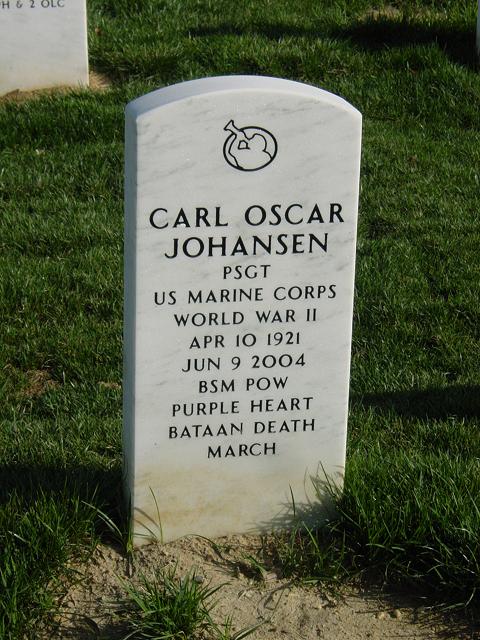From a contemporary press report:
Former Eurekan was Bataan Death March survivor
When a U.S. Marine is captured by the enemy and escapes during one of history's most terrifying marches to do battle again and be recaptured — it's the sort of thing that earns a fighting man a burial at Arlington National Cemetery with full military honors.
This is what former Eureka resident Carl Oscar Johansen, who died last month at the age 83, accomplished.
Johansen, whose two surviving siblings, Carla Deck and Pearl Medeiros, live in Cutten, enlisted in the U.S. Marine Corps in December 1939 — two years before the attack at Pearl Harbor that would thrust the United States into World War II and launch the conflict in the Pacific Ocean.
After training, as fate would have it, 20-year-old Johansen was assigned to the Bataan Peninsula in the Philippines, in April 1941, according to a biography that Johansen's family compiled.
The Japanese assault on the Philippines started the day after Pearl Harbor in December 1941.
The Japanese invaders shredded the forces of U.S. General Douglas MacArthur and by Jan. 6, 1942, 80,000 U.S. troops had retreated to Bataan.
Bataan fell in April 1942 after MacArthur fled to Australia.
It was the worst capitulation in U.S. history, as 70,000 American and Filipino fighting men surrendered to the Japanese, among them Johansen, who had suffered a shrapnel wound in the back while on patrol.
What happened next is one of the most infamous episodes in world military history, known today as the Bataan Death March.
Before it was over, those who survived would march more than 60 miles through intense heat with almost no water or food. Somewhere between 5,000 and 11,000 never made it to the march's destination, Camp O'Donnell, where fresh horrors awaited.
Johansen was among those who didn't arrive with the other marchers, because he escaped from his Japanese captors when the guards weren't looking, ran through the jungle to a beach, found a native boat and paddled it to the island of Corregidor, where he rejoined U.S. troops fighting the enemy as a machine gunner on the beach.
But the Japanese took the island in May 1942, and Johansen found himself a prisoner of war again.
He spent the rest of the war in POW camps in the Philippines and Japan. He was liberated in 1945.
Johansen moved to Eureka in 1946, where he worked as a mechanic with the Fred Barnett Co. for many years.
He later moved his family to Tucson, Arizona.
The Marine Corps would eventually award Johansen, who had achieved the rank of Platoon Sergeant during his service, the Purple Heart, Bronze Star, Combat Action Medal and POW Medal, among other decorations.
Johansen died of heart failure on June 9,2004.
A Marine Corps Honor Guard laid his coffin draped with a U.S. flag to rest at Arlington on July 6, 2004.
JOHANSEN, CARL OSCAR
PSGT US MARINE CORPS
VETERAN SERVICE DATES: 12/06/1939 – 04/02/1946
DATE OF BIRTH: 04/10/1921
DATE OF DEATH: 06/09/2004
DATE OF INTERMENT: 07/06/2004
BURIED AT: SECTION 69 SITE 3546
ARLINGTON NATIONAL CEMETERY
Michael Robert Patterson was born in Arlington and is the son of a former officer of the US Army. So it was no wonder that sooner or later his interests drew him to American history and especially to American military history. Many of his articles can be found on renowned portals like the New York Times, Washingtonpost or Wikipedia.
Reviewed by: Michael Howard

